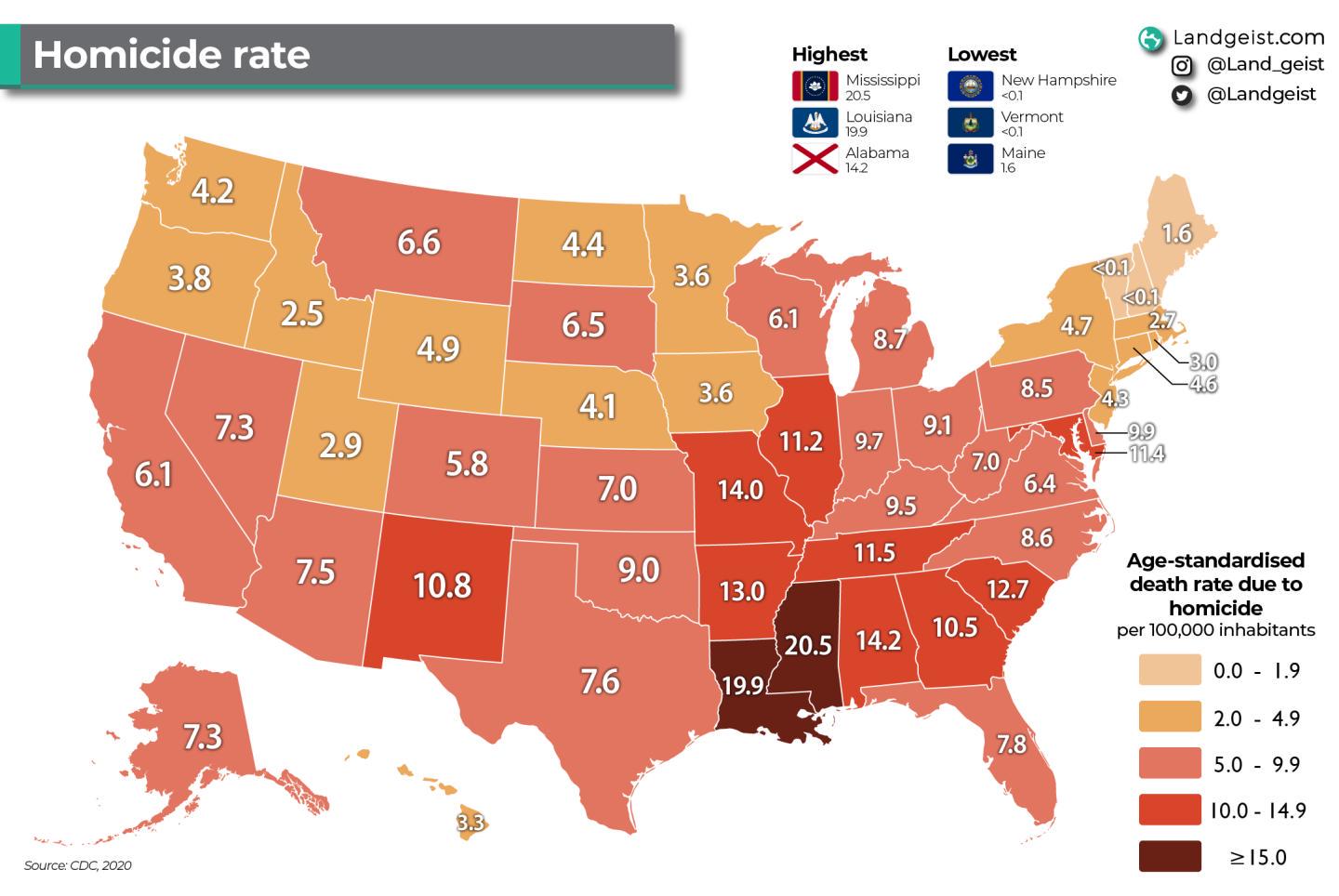US Homicide Rate by State Map


David Chen
Data Visualization Specialist
David Chen is an expert in transforming complex geographic datasets into compelling visual narratives. He combines his background in computer science ...
Geographic Analysis
What This Map Shows\nThis map provides a visual representation of the homicide rates across the United States, highlighting the differences in crime levels from state to state. By displaying these rates, it allows us to see where violent crime is most prevalent and where it is notably lower. This visualization doesn't just serve as a snapshot of crime statistics; it opens the door to discussions around public safety, social issues, and the factors that contribute to these disparities.
Deep Dive into Homicide Rates\nHomicide rates are a crucial indicator of public safety and societal health. Defined as the intentional killing of another person, these rates can vary significantly based on numerous factors, including socioeconomic conditions, access to firearms, community resources, and law enforcement practices. In 2023, the national homicide rate in the U.S. was approximately 6.9 per 100,000 individuals, a rate that has seen fluctuations over the past decade due to various influences, including the COVID-19 pandemic, social unrest, and economic instability.
Interestingly, states with higher homicide rates often share common characteristics, such as higher poverty rates, lower educational attainment, and urbanization. For instance, states like Louisiana and New Mexico have consistently reported some of the highest homicide rates in the nation. In Louisiana, the homicide rate has been alarmingly high, with figures reaching upwards of 15 per 100,000 residents. Factors contributing to this include a history of poverty, high rates of gun violence, and systemic issues within communities.
On the other hand, states like New York and Massachusetts boast significantly lower homicide rates, often hovering around 3-4 per 100,000. These states tend to have better access to education, healthcare, and community services, which play a critical role in preventing violent crime. The contrast between these states raises important questions about resource allocation and community support systems.
Moreover, the impact of gun control laws cannot be overlooked when discussing homicide rates. States with stricter gun laws, such as California and New Jersey, typically report lower rates of gun-related homicides. In contrast, states with more permissive laws, like Alaska and Alabama, have seen higher incidences of gun violence. This correlation highlights the ongoing debate over the effectiveness of gun regulations in curbing violent crime.
Regional Analysis\nWhen breaking down the map by regions, distinct patterns emerge. The South, often characterized by higher homicide rates, contrasts sharply with the Northeast, where rates are significantly lower. For example, in 2022, the Southern states had an average homicide rate of 10 per 100,000, compared to the Northeast's average of around 4 per 100,000. This discrepancy can be attributed to various factors, including economic disparities, cultural differences, and varying levels of law enforcement engagement.
The Midwest presents a mixed picture; states like Illinois and Michigan show elevated homicide rates, particularly in urban areas like Chicago and Detroit, while rural areas tend to have much lower rates. In contrast, states such as Minnesota maintain a relatively low homicide rate, thanks in part to effective community programs and law enforcement strategies.
In the West, states like Nevada and New Mexico struggle with higher homicide rates, often linked to tourism and transient populations that may contribute to crime spikes. Conversely, states such as Washington and Oregon report lower rates, likely due to a combination of socioeconomic factors and effective prevention programs.
Significance and Impact\nUnderstanding homicide rates is crucial for several reasons. They serve as indicators of broader societal issues, including poverty, health care access, and community cohesion. High homicide rates can lead to increased fear among residents, impacting their quality of life and local economies. Additionally, these figures can inform policymakers and community leaders as they work to develop interventions aimed at reducing violence.
Interestingly, trends show that while national homicide rates had a dramatic rise during the pandemic, there is evidence to suggest that many communities are actively working to address these issues through various initiatives. For instance, cities across the nation are implementing community policing strategies, focusing on building relationships between law enforcement and community members to foster trust and collaboration.
As we look to the future, it’s essential to consider how ongoing discussions around gun control, economic support, and community resources will continue to shape the landscape of homicide rates across the United States. Moving forward, data-driven approaches will be key in creating safer environments for all citizens, making the understanding of these rates not just a matter of statistics but a vital conversation for public health and safety.
Visualization Details
- Published
- October 26, 2025
- Views
- 12
Comments
Loading comments...